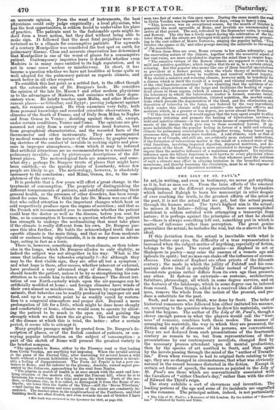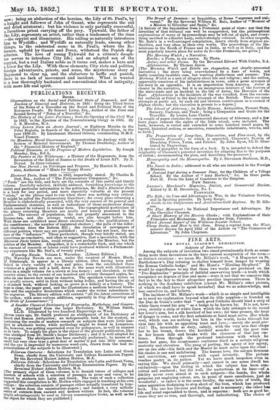THE LILY OF ST. PAUL'S. *
Ix art, in writing, and even in testimony, we never get anything as it is, but as men see it. From the lame efforts of the amateur draughtsman, or the different representations of the bystanders , which induced Raleigh to burn his manuscript in utter despair of ever reaching the truth, to the greatest efforts of the artist or the poet, it is not the actual that we get, but the actual passed through the human mind. The tyro's highest aim is the actual; he misses it by failure—falling Short. The more accomplished proficient is seldom satisfied with attempting a transcript from nature; it is perhaps against the principles of art that he should be—there is always something left out, something put in which is matter of inference rather than perception. The great genius generalizes the actual; he includes the real, but riani above it to the ideal.
If this deviation from the actual is inevitable with what is passing before our eyes, the difficulty of a trine representation is increased when the subject-matter of anything, especially of fiction, belongs to the past. The rarest genius—as Raphael in art or Shakspere in poetry—may seize the essence of a remote age and indicate its spirit; but no man can shake off the influence of circum- stances. The saints of Raphael are often priests of the fifteenth century ; the mode in which the jollity of Falstaff and his com- panions shows itself is probably Tudor instead of Plantagenet. Second-rate genius rather differs from its own age than presents any other. It fastens on externals—as e,ostiune, architecture, furniture, phraseology, all which in some degree survive, and on the features of the landscape, which in some degree can be inferred from record. These things, added to a received idea of olden man- ners, remove the whole from the notion of the presents and pro- duce a substitute for the past. Such, and no more, we think, was done by Scott. The tribe of historical romancers who followed him either imitated his manner, or' recurring to the quarries whence he drew his materials, carica- tured the bygone. The author of The Lily of St Paul's though a clever enough person in what the players would call ;he "busi- ness" of romance, combines both these modes. The manner of arranging his materials, the way in which they are presented, the diction and style of discourse of his persons, are conventional. They are not deduced from such presentations of the fourteenth century as remain to us, but from representations of those presentations by our contemporary novelists, changed first by the necessary process attendant upon all mental productions, then by the species of art ascribed to Scott, and then again by the novels passing through the mind of the "author of Trevetli- Ian." Even when recourse is had to original facts relating to the age, they are so changed in circumstances, that what was obviously natural in the record becomes distorted in the fiction. Except in certain set forms of speech, the manners as painted in the Lily of St. Paul's are those which are conventionally associated with the Cavaliers of "either Charles's day," rather than with the olose of Edward the Third's reign.
The story exhibits a sort of cleverness and invention. The leading persons of the age and some of its incidents are engrafted on the romance. The principal action, indeed, is not particularly
* The Lily of St. Paul's; a Romance of Old London. By the Author of' Treveth- Ian." Published by Smith and Elder.
new; being an abduction of the heroine, the Lily of St Paul's, by a knight and follower of John of Gaunt, who represents the cut mid dried aristocrat ; but his violence is only partially successful, a licentious priest carrying off the prey. Tynwald, the father of the Lily, represents an artist, rather than a tradesman of the time .—the copyist and illuminator. His calling as naturally introduces him to Wycliffe; and Wycliffe as naturally leads, among other things, to the celebrated scene in St. Paul's, where the lb: former, upheld by Gaunt and Percy, withstood the Popish dig- nitaries. The love of young Tynwald for a citizen's daugh- ter serves to introduce City life ; and an adopted son of the copyist, but a real Italian noble as it turns out, makes a hero and a lover for the Lily. With these elements, City riots and politics, foreign adventurers, priests, and nuns, the mysterious story of Raymond to clear up, and the abductors to baffle and punish, there is no lack of movement and incident What is wanted is a less thoroughly hacknied and conventional idea of antiquity, with more life and spirit.



























 Previous page
Previous page